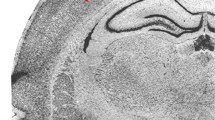Summary
A mouse colony was established in which lymphocytic choriomeningitis virus was transmitted congenitally, thus rendering the mice immunologically tolerant to the virus. The birth and growth rates of the infected mice were lower than those of normal mice, while the mortality during the first year of life was higher. These results suggest that in congenitally infected, immunologically tolerant mice lymphocytic choriomeningitis virus produces a chronic infection of low cytopathogenicity which ultimately causes sufficient tissue damage to impair vital processes and shorten life.
Similar content being viewed by others
References
Burnet, F. M.: Principles of Animal Virology, 1st ed., p. 254. New York and London: Academic Press, 1960.
Burnet, F. M., andF. Fenner: The Production of Antibodies, 2nd ed., p. 104. London and Melbourne: Macmillan, 1953.
Hotchin, J. E.: The biology of lymphocytic choriomeningitis infection: virus induced immune disease. Cold Spr. Harb. Symp. quant. Biol.27, 479–499 (1962).
Hotchin, J. E., andH. Weigand: Studies of lymphocytic choriomeningitis in mice. 1. The relationship between age at inoculation and outcome of infection. J. Immunol.86, 392–400 (1961).
Lehmann-Grube, F.: Lymphocytic choriomeningitis in the mouse. II. Establishment of carrier colonies. Arch. ges. Virusforsch.14, 351–357 (1964).
Rowe, W. P.: Studies on pathogenesis and immunity in LCM infection in the mouse. U. S. Naval Med. Research Inst. Research Rep.12, 167–219 (1954).
Seamer, J., A. W. Gledhill, J. L. Barlow, andJ. Hotchin: Effect ofEperythrozoon coccoides upon lymphocytic choriomeningitis in mice. J. Immunol.86, 512–515 (1961).
Seamer, J., J. L. Barlow, A. W. Gledhill, andJ. Hotchin: Increased susceptibility of mice to lymphocytic choriomeningitis virus after peripheral inoculation. Virology21, 309–316 (1963).
Traub, E.: The epidemiology of lymphocytic choriomeningitis in white mice. J. exp. Med.64, 183–200 (1936).
Traub, E.: Factors influencing the persistence of choriomeningitis virus in the blood of mice after clinical recovery. J. exp. Med.68, 229–250 (1938).
Traub, E.: Epidemiology of lymphocytic choriomeningitis in a mouse stock observed for four years. J. exp. Med.69, 801–817 (1939).
Traub, E.: Über die natürliche Übertragungsweise des Virus derlymphocytären Choriomeningitis (LCM) bei Mäusen und ihre Parallelen zum Übertragungsmodus gewisser muriner Krebsviren. Zbl. Bakt. I, Orig.177, 453–471 (1960).
Traub, E.: Über die immunologische Toleranz bei der lymphocytären Choriomeningitis der Mäuse. Zbl. Bakt. I, Orig.177, 472–482 (1960).
Traub, E.: Can LCM virus cause lymphomatosis in mice? Arch. ges. Virusforsch.9, 667–682 (1962).
Volkert, M.: Studies on immunological tolerance to LCM virus. 2. Treatment of virus carrier mice by adoptive immunisation. Acta Path. Microbiol. Scand.57, 465–487 (1963).
Author information
Authors and Affiliations
Rights and permissions
About this article
Cite this article
Seamer, J. The growth, reproduction and mortality of mice made immunologically tolerant to lymphocytic choriomeningitis virus by congenital infection. Archiv f Virusforschung 15, 169–177 (1965). https://doi.org/10.1007/BF01257728
Received:
Issue Date:
DOI: https://doi.org/10.1007/BF01257728




